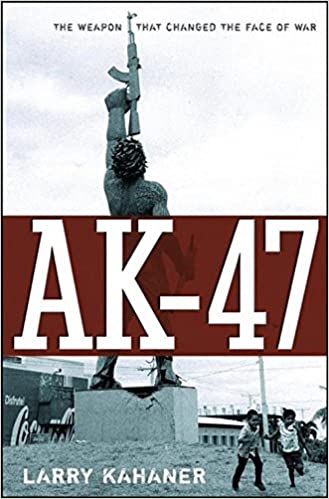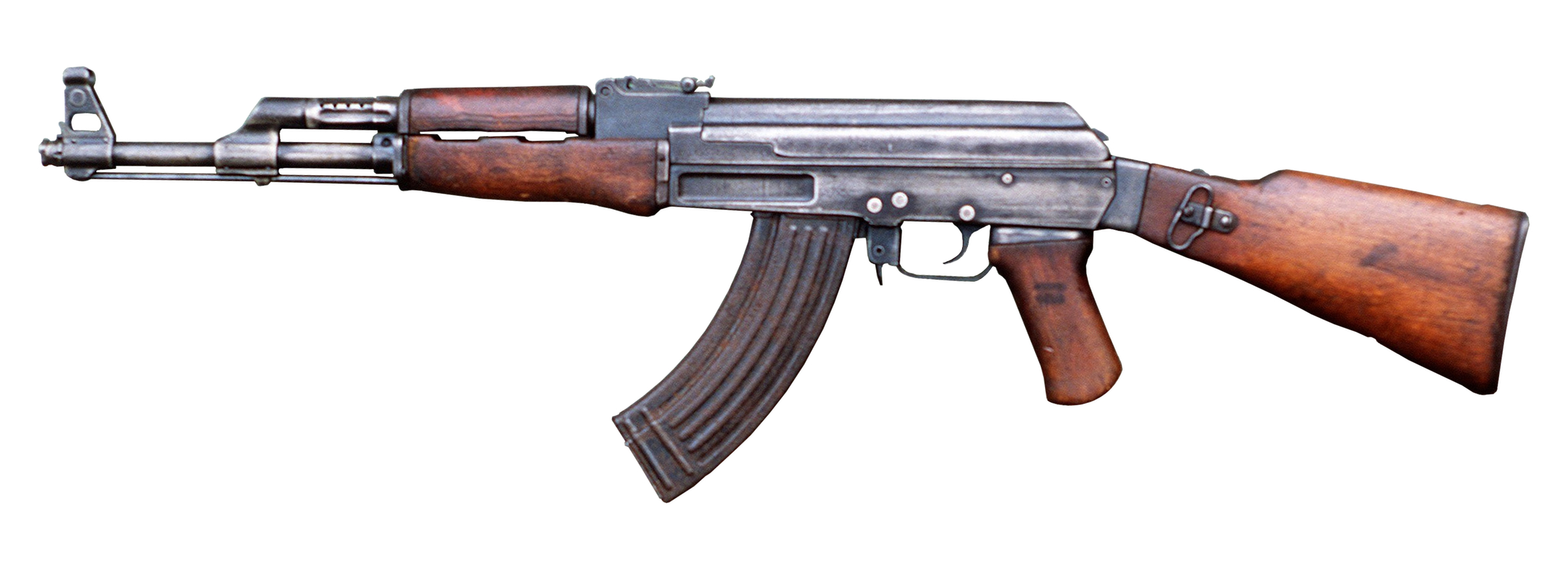 A year ago, I wrote about C. J. Chivers’ The Gun. I just read another book about the AK-47 assault rifle. This one being Larry Kahaner’s AK-47: The Weapon That Changed the Face of War. This is the earlier book (2008), while Chivers’ book came out in 2011.
A year ago, I wrote about C. J. Chivers’ The Gun. I just read another book about the AK-47 assault rifle. This one being Larry Kahaner’s AK-47: The Weapon That Changed the Face of War. This is the earlier book (2008), while Chivers’ book came out in 2011.
AK-47 begins with the assault on Baghdad by Apache helicopters in 2003. The met a hail of thousands of rounds from Iraqi ground troops damaging most of the helicopters and cutting their mission short. I remember reading about this. Kahaner starts the narrative with Mikhail Kalashnikov wounded in the Battle of Bryansk by German submachine guns. Kalashnikov first designed submachine guns that were rejected as too complex. Kahaner segued into the development of the German Sturmgewehr and the intermediate rifle cartridge including the advantages over pistol cartridges used in submachine guns. He does explain some mechanics of firearms including blow-back and short-stroke systems. Kahaner is dismissive of the U.S. M-1 (Garand) rifle. Granted, it would have been better in the original .276 cartridge, but it still was a winner for WW2.
The development, modifications, and adjustments up to approval for production in 1947 is covered. Eighty thousand AKs were produced by 1949. Kahaner covers Soviet battle doctrine also and how the AK fit perfectly with Communist blitzkrieg. The AK made its debut in the 1956 Hungarian uprising.
Kahaner gets right into it with the AK-47 used in Vietnam. The story becomes intertwined with history of the infamous AR-15. Space is given to Col. Rene Studler of U.S. Army Ordnance. He was the one with Gen. Matthew Ridgeway’s approval that the U.S. Army under no circumstances would use a European rifle (the FN FAL) or a European rifle cartridge (the British 7 x 43 mm). A shame as that combination would have been a winner. The U.S. forced NATO to use the 7.62 x 51 mm cartridge while it adopted the M-14 rifle, a supposed upgrade of the M-1 rifle. The advantage of the AK was demonstrated in jungle fire fights in Vietnam. The story of Eugene Stoner’s development of the AR-10 and then AR-15 using new materials and a new cartridge (the .223/5.45 x 45 mm) is covered. Gen. Curtis LeMay, head of the U.S. Air Force bought a few thousand AR rifles to replace the M-1 carbine thus giving a back door for the AR. Robert McNamara killed the M-14, adopted the AR as the M-16 as it was cheaper. Most of this chapter is more about the AR-15/M-16 than the AK-47. Problems with jamming, fouling, and corrosion of the rifle due to possible sabotage by Army Ordnance who wanted the M-14 rifle back is part of the story.
The book makes a jump with the chapter “Pandora’s Box.” This covers the Soviet invasion of Afghanistan in 1979. I did not know the first rifles sent to the Afghan mujahideen were British .303 Lee-Enfields. The CIA thought they would be of better use in the long-distance shooting. Not the case as the Afghans would ambush Soviet and Afghan Army convoys shooting it up with AKs on full auto. The Afghans liked the AK-74 that used the 5.45 x 39 mm cartridge. The Afghans had difficulty controlling the AK-47 using the 7.62 x 39 mm cartridge. This I did not know either. The AK proliferated in Afghanistan and Pakistan becoming “Kalashnikov Culture.” This became a recurrent story- areas of the globe destabilized awash in AK-47 rifles.
“The African Credit Card” has the story of Liberia and rebel Charles Taylor and his child soldiers using AKs. Soviet bloc counties were selling AKs for quick cash. African countries splintered as tribes and warlords would get some AK-47s and overthrow the government.
Latin America is given a chapter. Kahaner’s main focus is on the over-throw of Samoza in Nicaragua and the subsequent Sandinista regime. Kahaner seems sympathetic to the Sandinistas acquiring AK of their own to defend against the Contras. I remember that period and the Sandinistas were a conduit for the Cubans supplying Communist rebels in neighboring El Salvador. I also remember the Sandinistas had a paratrooper regiment by the mid-1980s. Paratroopers are not defensive troops. He covers the AK-47 in South American in Peru and Columbia with Communist rebels. He recounted a story I remember of Hugo Chavez of Venezuela buying 100,000 in the new AK-100 series. Those are AKs with fiberglass stocks and chambered for 5.56 x 45 or the traditional 7.62 x 39 cartridge. Cocaine traffickers liked the AK-47. Who doesn’t?
More space is given to Mikhail Kalashnikov’s later life. “AK Versus M-16: Part 2” covers the Iraq War. I did not know the M-4 carbines used had a problem with slower bullet velocity that lost lethality at longerer distances. I had not heard about any problems with the M-4 including some unreliability issues when it overheated on full automatic fire. Tank crews were picking up and using AKs as two had 9 mm pistols and the other two had M-4 carbines. I was just told Marine Corpsmen were using AKs also.
Kahaner put it well:
“It seemed to many that the war in Iraq was being fought with too few soldiers, inadequate small arms, subpar body armor, and ill-matched vehicles.”
The new Iraqi Army refused American made M-16s and M-4s. They insisted on AKs. Kahaner goes into the twisted story of the U.S. procuring AK rifles from the Jordanian conglomerate International Trading Establishment and sub-contractor China-based Poly Technologies. Kahaner asked the question of there were hundreds of thousands of AKs captured from Saddam Hussein’s stockpiles. Why not just outfit the Iraqi Army with those?
This book has a little more emphasis on cultural impact of the AK-47 since its inception in comparison to Chivers’ book. You realize the AK-47 and variants is cheap and reliable. That is going to beat out more expensive and fragile rifles. I think there are a few more chapters in the history of the AK-47 family of assault rifles. It is a great weapon for jungle and urban warfare. I think we will see the latter sooner or later. I am curious how the AK using the Chinese 5.8 x 45 mm cartridge performs.

“paratroopers are not defensive troops.”
Tell that to the battling Bastards of Bastogne.
I like this because the way how you mix it up sometime and give other topic.